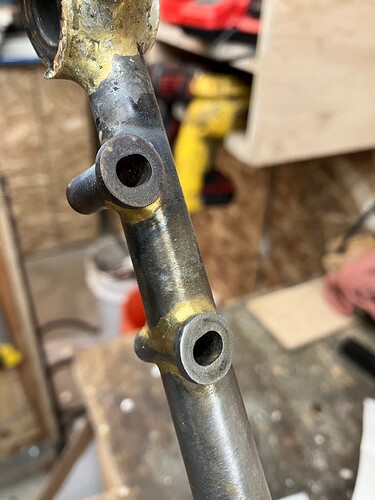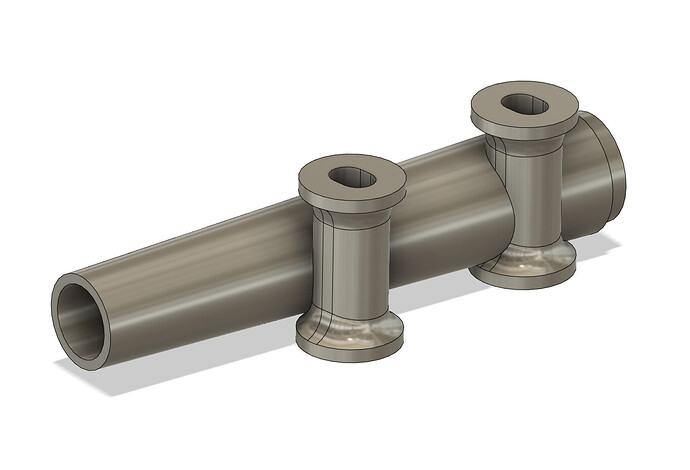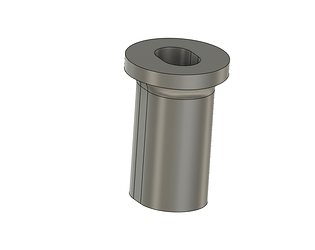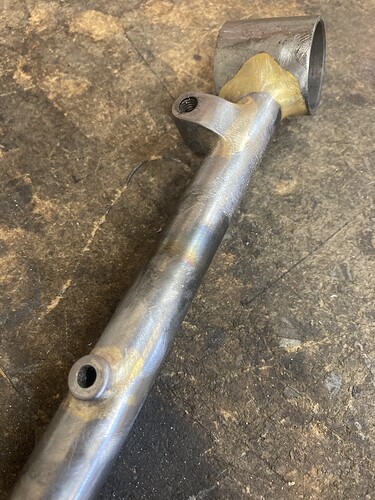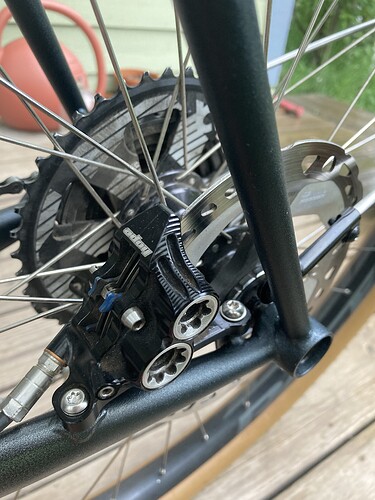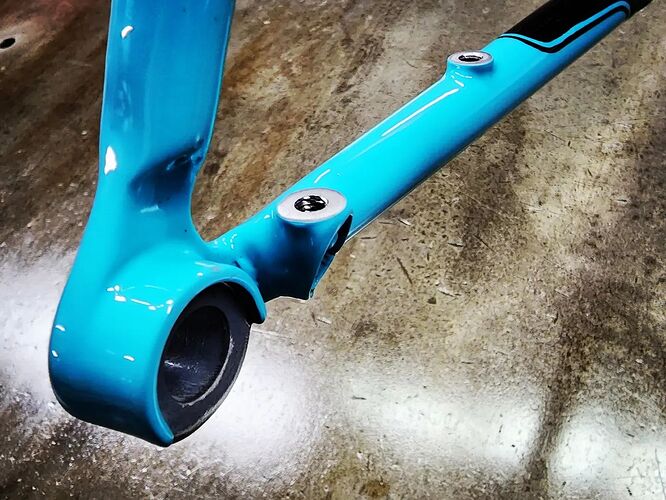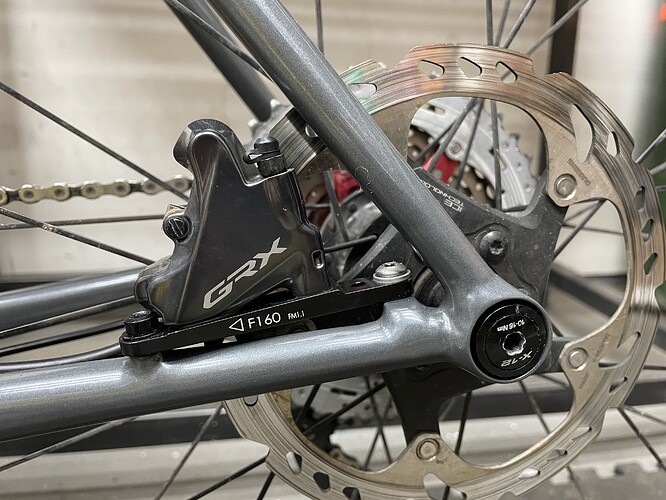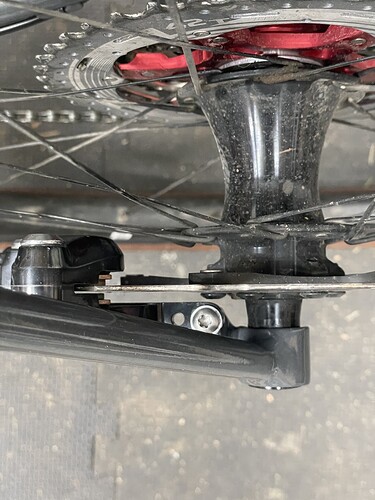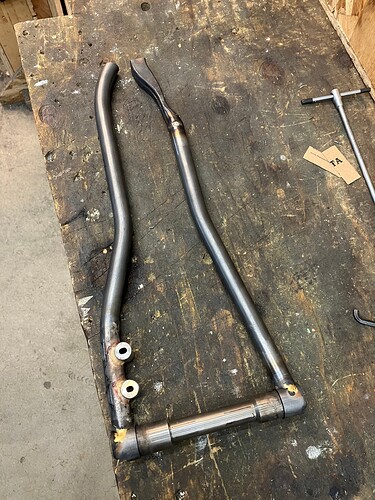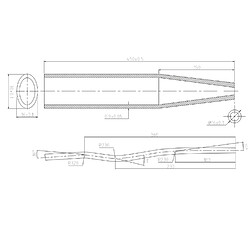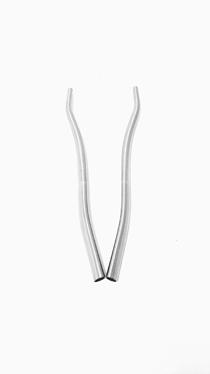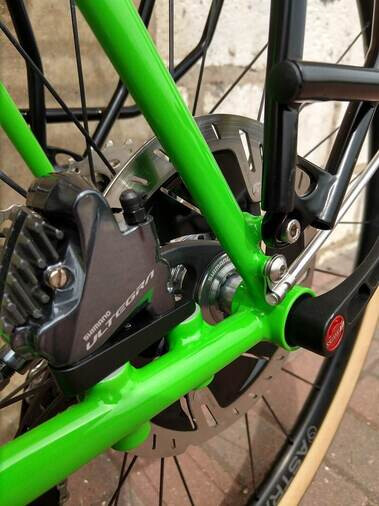Wondering if there are other disc caliper mounts available other than the Paragon 0.625 diameter versions. Something with a smaller diameter. Rob English uses something that looks great, but I don’t think they’re available for purchase. I truly dislike cutting a 5/8" hole in my chainstays. Makes me nervous. Just another reason I dislike disc brakes. Woe is me.
I’ve made some caliper mounts from 1/2" rod, similar to what English does. It’s very slightly under spec for the 13mm top diameter, but it works fine.
I made them as long as I could from the longest 5.2mm end mill I could find, which was 20mm. Then the turned down part was 8mm diameter. It was a couple of years ago. Anyways, it’s a pretty easy project, even for a non-machinist with a clapped out lathe and little benchtop mill. Then the washer and bolt head sits on the bottom face of the mount.
It would be great to get something like this commercially made. Hell, I guess it would be a pretty easy 3d-printed part since the tolerances don’t need to be that tight. ![]()
Nice, that is a pretty slick solution. 8mm is much better than 16mm hole needed.
This is a 3D printed design (the entire part is 3D printed). But the hourglass bosses could easily be printed or machined. The thin section is 9.2mm wide in that design. Could be thinner if it were machined.
I found the tricky part is the length of the bosses. I find that 20mm is too short for some chainstays, and 25mm is too long! Since the FM bolts are blind, it has to be exactly 20 or 25mm otherwise the bolts bottom out…
Did a quick design. It’s a 12g part, so $3-4ea to be 3D printed. Not the most cost-effective part. Should be pretty easy to machine.
That is perfect! Let’s do this! Maybe we can get Mark at PMW in on it?
That is pretty sweet. My issue is that I don’t have a lathe or a mill but have access to a small mill which is what I use now.
Ya, 20mm only works with FM140 and tapered stays. Since I almost exclusively use FM160 and 3/4" stays, 20mm is too short. Paragon’s 1.25" caliper mounts are the right length for that setup.
If @mark_pmw produced some out of stainless in a 1.25" length, that’d be a nice win.
As to the bolt length, it’s easy enough to grind down a too long bolt so it doesn’t bottom out inside the caliper. Proprietary bolt lengths FTW!
I know I’ve seen a few other people doing this, but here’s the couple bikes I’ve built/am building with fork flat mount standard in the rear. I’m sure there’s a few ways to do it, but smaller bosses and easier brake adjustment. None of it done with a mill, could be, but almost as fast with some careful hand drilling and filing.
What did you use for the rearward mount?
On the first frame (powder coated) I think I used a 3/8” 4130 tube, that had an ID close to 4.2mm or less. Drilled and tapped for m5. Moved the chainstay to the inside of the dropout (don’t love the way this looks). Slightly mitered the 3/8” boss with a file to chainstay.
The in progress photo was 3/8”x3/4” flat bar chunk. Drilled and tapped m5 on 3/8” face. Then mitered with 1/2” end mill to fit 12.5-13mm CS. Took a few minutes to get the miter right, but only took a minute or two to miter another for a buddy. Didn’t move the chainstay in. Shaped the boss on belt sander otherwise it’d be square on top of the chainstay.
A couple friends/coworkers also just used 3/4” or larger straight gauge chainstays and both 3/8” round bosses contacted the chainstay naturally.
Oh yours looks better! Maybe I stole that idea from you?
HPDX made a set of the flat mounting bits for me, and I’m really happy with how the setup works. Easier to adjust the rear brake, and no machining required on the chain stay. I drilled a hole using a standard cordless drill for the front mount, and the rear mount was simply shaped to conform to the stay using hand files.
Easy access to the bolt to adjust caliper alignment, however you can see there isn’t a ton a clearance with the rotor bolts.
Haha. Thanks. I honestly can’t remember if I did without seeing anyone else or whether I saw it just adopted it. I have been trying to think back but I don’t think I can claim it as being my idea to be honest. I’ve been helping Brandon at Bahl get his head aorund the dimensions etc. so there are a few of us adopting the setup. I think for metal frames that aren’t 3d printed frame ends incorporating the flat mount it is a better solution.
These are cool looking parts, and if you can get them 3d printed for 3-4 dollars that sounds like a steal to me!
To machine these the tough part is the long sickout/length of cut (LOC) needed from the small diameter endmill to make that slot so long. You would drill it, then plunge it out a bunch, then interpolate to finish with something like a 3/16dia x 1"LOC endmill. A tool that small in dia with that long LOC is very flimsy. This is entirely possible, clearly as @manzanitacycles did an awesome job making some, but babying flimsy tooling is time consuming, and time = $.
Lets say you are working with a shop rate of $100/hr, which is on the low end of what machine shops need to charge to stay a float. As an experienced manual machinist, with a manual lathe and mill, and the appropriate setup equiptment, I would say I could make a pair of these in 30min-1hr. That makes these a $50- $100 pair of brake mounts if done in a job shop. This is likely why you don’t see anybody who is making these to use on their own bike builds making extra to sell.
So lets think about production machining. Everything happens faster and more efficient, but you still have to baby that long endmill. Instead of an hour for a pair, they would probably take about 3min a piece. That same 100$/hr = 1.66$/min. So you have to charge 5$ just for the cycle time. Then you’ll have about 3 hours of machine setup and proving time, that’s 300 fixed cost you spread as thin as possible. most shops have a 25-50part minimum, so say you make 50 parts, that’s a setup cost of another 6$ per part. Then maybe $0.50 in material. We are already up to $11.50 per mount, this doesn’t include the programming cost or tooling cost because I’m running on the assumption that there would be enough demand to warrant adding them to a product line and making these every few months. If a shop could sell heaps of them they could lower the overall cost by making more parts in a run and spreading the fixed cost out thinner, but it will never touch $3.
CNC machined parts are awesome, and there are a lot of pros to machining over 3D printing. But for the part you have designed here, especially since you don’t need the precision tolerances, 3D printing would be the way to go for sure.
Is this just an aesthetic preference? Or is there another reason that you see an 8mm hole is better than 16mm?
A 16mm hole removes a lot of material from the stay. I have to make custom triple bend chainstays when I use those caliper mounts in order to preserve a majority of the stay body. It works fine but it wouldn’t be so exaggerated with a smaller 8mm hole.
Thanks for that detailed post about the true cost of CNC. I only have good intuition with 3D printed costs, so its great to learn more about CNC.
Flat mount and pre-bent road/gravel are all over the place right now. The vast majority of chainstays are designed for rim brake quick-release bikes.
As far as I know, these are the only chainstays designed specifically to leave room for flatmounts:
Columbus Life: Life Disc Chain Stay, Gravel '3' Bend 24OV x 450, NO SMASH – Metal-Guru.com
Deda Gravel: 24MM Ø ZERO UNO GRAVEL BEND CHAIN STAY 1.0/.7 X 440MM MPO240C2026 — BICYCLE FABRICATION SUPPLY
The flatmount topic keeps coming up every month. It’s a pretty difficult problem to solve, even with 3D printing. I am eventually going to design a pre-bent, pre-dimpled chainstay that is specifically engineered to work with gravel drivetrains (GRX road wide) and flatmount bosses.
Ah, I see that as being a challenge. I appreciate the insight as I’m not a framebuilder myself. The exaggerated bend definitely gives it less than desirable asymmetry. I was under the impression that most people pair the flat mount bosses with round dropouts by mitering and welding both bosses into the chainstay in line like this photo from the googles -
It would clearly remove an amount of the tubing structure, but would then replace it with significantly more structure, like a thick walled scaffold.
Plus with the larger diameter bosses you get a countersink so you don’t have a bolt head hanging out the bottom.
I guess at the end of the day, no matter how you spin it flat mounts are a PITA
Lets all go back to ISO? Anyone?.. Bueller?..
